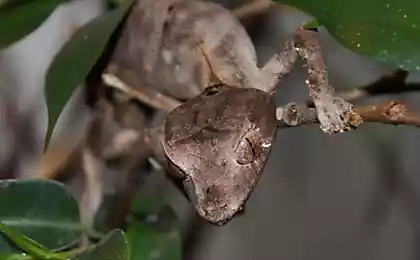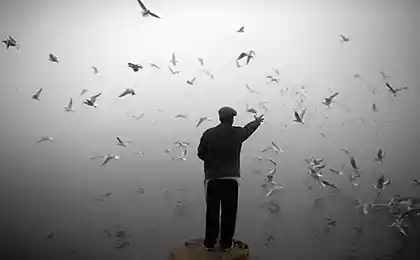160
Strange New Caledonian ciliated gecko
First discovered in 1866, the New Caledonian ciliated gecko (Latin Correlophus ciliatus) was long considered an extinct species, and only in 1994 it was rediscovered after a tropical storm on a small group of islands northeast of Australia, the center of which is New Caledonia.
Small, growing up to 22 cm along with the tail, which accounts for half the length of the body, ciliated geckos spend their lives in trees, eating fruits, insects and small animals.
They got their name due to the skin growths around the eyes, similar to wide-open eyelashes. These cute reptiles do not have eyelids, and the eyes are protected by a transparent film, which the geckos clean with their tongue.
New Caledonian ciliated geckos are nocturnal animals. During the day, they sleep on branches, comfortably sitting under leaves away from prying eyes, and at night go hunting. By changing color depending on temperature and time of day, ciliated geckos can turn orange, red, yellow, olive and even gray.
The finger pads and tail tip of these night hunters are covered with small villi, thanks to which they can easily move on smooth vertical surfaces, including glass. In jumping between branches, they are helped by strong legs with claws and a long tenacious tail. The skin of ciliated geckos is soft, touching like suede.
Like other geckos, in case of danger, they cast their tail, distracting the attention of predators. But unlike their relatives, New Caledonian ciliated geckos do not grow new tails, and as a result, most adult geckos are tailless.
Source: zoopicture.ru
Small, growing up to 22 cm along with the tail, which accounts for half the length of the body, ciliated geckos spend their lives in trees, eating fruits, insects and small animals.
They got their name due to the skin growths around the eyes, similar to wide-open eyelashes. These cute reptiles do not have eyelids, and the eyes are protected by a transparent film, which the geckos clean with their tongue.
New Caledonian ciliated geckos are nocturnal animals. During the day, they sleep on branches, comfortably sitting under leaves away from prying eyes, and at night go hunting. By changing color depending on temperature and time of day, ciliated geckos can turn orange, red, yellow, olive and even gray.
The finger pads and tail tip of these night hunters are covered with small villi, thanks to which they can easily move on smooth vertical surfaces, including glass. In jumping between branches, they are helped by strong legs with claws and a long tenacious tail. The skin of ciliated geckos is soft, touching like suede.
Like other geckos, in case of danger, they cast their tail, distracting the attention of predators. But unlike their relatives, New Caledonian ciliated geckos do not grow new tails, and as a result, most adult geckos are tailless.
Source: zoopicture.ru
The General public has introduced the electric tractor at the exhibition "AGRO-2014"
Ideas for business—growing flowers in a greenhouse























